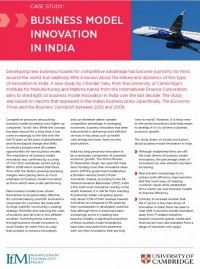Business model innovation in India

 |
Developing new business models for competitive advantage has become a priority for firms around the world, but relatively little is known about the nature and dynamics of this type of innovation in India. A new study by Chander Velu, from the University of Cambridge’s Institute for Manufacturing and Mahima Kanna from the International Finance Corporation, aims to shed light on business model innovation in India over the last decade. The study was based on reports that appeared in the Indian business press (specifically, The Economic Times and the Business Standard) between 2001 and 2008.
Competitive pressures are pushing business model innovation ever higher up companies’ ‘to do’ lists. While the concept has been around for a long time, it has come increasingly to the fore over the last 15 years as the pace of globalisation and technological change and shifts in industry borders have all created opportunities for new business models. The importance of business model innovation was confirmed by a survey of 700 CEOs worldwide carried out by IBM in 2008 which showed that those firms with the fastest-growing operating margins were placing twice as much emphasis on business model innovation as those which were under-performing.
New business models have shown themselves to be particularly effective for commercialising scientific innovations (important for countries like India with its large scientific community), creating strategic flexibility and reducing the costs of products and services in less affluent societies. Achieving these outcomes through business model innovation is much harder for other firms to copy than product or process innovations and can therefore deliver greater competitive advantage. In emerging economies, business innovation has been instrumental in delivering more efficient services in key areas such as health care, energy provision, food security and nutrition.
India has long perceived innovation to be a necessary component of sustained economic growth. Dr Manmohan Singh, who was Prime Minister from 2004 to 2014, has said that India lacks funding more than innovative ideas and in 2011 the government established a $1 billion venture fund to foster innovation. Indeed, according to the GE Global Innovation Barometer (2012), India is the sixth most innovative country in the world. However, it is still far from reaching its potential; Indian companies spend only about 0.3% of their revenue towards innovation as compared to 3% spent by their counterparts in developed countries. And although firms in India have been increasingly active in creating new business models, a significant proportion of these business model innovations have been borrowed from elsewhere with very few innovations that are truly ‘new-to-world’. However, it is these new-to-the-world innovations that India needs to develop if it is to achieve sustained economic growth.
The study draws six broad conclusions about business model innovation in India:
|
Although established firms are still the main drivers of business model innovations, the percentage share of innovations by new entrants has been increasing. |
|
|
New entrants increasingly try to achieve both efficiency improvements and find novel ways of meeting customer needs while established firms mainly use new business models to improve efficiency. |
|
|
Contrary to received wisdom that the IT sector is the main driver of innovation in India, there has been a clear shift in business model innovation away from IT-related industries towards consumer goods, media and financial services (see examples from a range of industries over page). |
|
|
New entrants introduced business model innovations that were primarily ‘new-to-industry’, whereas established firms tended to introduce innovations that were ‘new-to-firm’. |
|
|
Business models based on new ways of meeting customers’ needs adopted by both new entrants and established firms were predominantly new-to-firm. Efficiency-centred business models, however, differed according to the type of firm, with new entrants predominantly introducing new-to-firm innovations while established firms tended to develop new-to-industry models. |
|
|
Over time, the novelty-centred business models changed from being predominantly new-to-industry to new-to-firm, whilst efficiency-centred business models remained relatively unchanged in terms of the newness of innovation. |
|
|
|
Somewhat unexpectedly, the study also shows that most business model innovations in India were either new-to- firm or new-to-industry but not new-to-world.
EXAMPLES OF BUSINESS MODEL INNOVATION ACROSS A RANGE OF INDUSTRIES
|
Consumer Until 2003 most FMCG companies in India catered to urban markets. In 2004 Unilever lead most of the industry to shift the focus towards rural India. Distribution and warehousing were redesigned and new products were launched. Existing products, such as Sunsilk shampoo, were repackaged into smaller sachets that were affordable in rural areas. |
|
Transport/travel The IndiGo airline revolutionised the low-cost carrier industry in 2000. By adopting an efficiency-centred business model, it established itself as the leader in the Indian low-cost carrier fraternity, providing excellent customer service, fast check-in and low prices. |
|
Financial services Innovation in the financial services industry was rapid and widespread in India as it had been in the rest of the world. An established firm, Future Group, set up a subsidiary, Future Capital Holding (FCH), to provide financial services to clients over the counter in their retail chain, Pantaloons. With over 400 branches of Pantaloons across the country, FCH initially provided consumer and personal loans to clients to purchase durable and other goods and expanded its portfolio into credit cards, life and general insurance, home loans and money transfers. |
Implications for policymakers
Given the trend for innovations to be increasingly driven by new firms, one of the key policy implications is that public support could be used to help foster more entrepreneurial businesses in India, perhaps introducing a programme like ‘Enterprise Ireland’, which provides coaching, mentoring and help for entrepreneurs within a framework for developing new business models.
Public funding should also reflect the findings that new entrants tend to favour novel ways of transacting business while established firms tend to focus on efficiency improvements. For example, public-private funding could be used to encourage established firms to develop efficiency-centred improvements whereas, if new types of transactions – or completely new markets – are a priority, public funds are arguably better directed at new entrants. Similarly, the study highlights that business model innovation in the IT sector is declining and therefore government support might be better spent on sectors such as consumer goods, media and financial services which have been showing much greater levels of innovation. However, there also perhaps needs to be further investigation as to why the IT sector is not at the forefront of business model innovation and if there is a need to develop a new government-aided National System of Innovation (NSI) to keep India ahead of nearby lower-cost economies.
In general, the lack of new-to-world innovations was surprising given the active and vibrant nature of scientific research more broadly in India and the concomitant opportunities in important industries such as healthcare and education. The authors suggest that perhaps a more comprehensive study is needed to encourage new-to-world business model innovations in India that will turn scientific breakthroughs into commercially viable propositions. The opportunities are clearly abundant and public policy has a role to play in catalysing the future of Indian business model innovation by helping firms to change, enhancing their learning capabilities, and developing knowledge pools and state-of-the-art management processes. Moreover, both market and state must play a collaborative role in designing the future of India Inc.’s competitiveness in the global sphere.
The full research paper appeared in Journal of Indian Business Research, Volume 5 Issue 3, 2013.
For more information, please contact Chander Velu E: c.velu@eng.cam.ac.uk
Download the pdf here.










